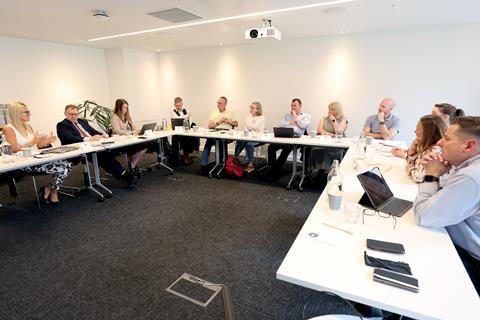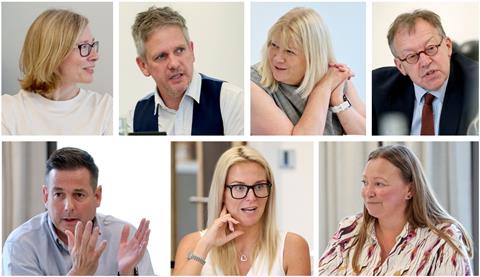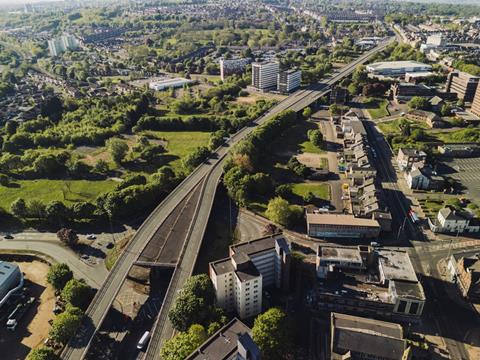In Newcastle last month, the �ǿմ�ý the Future Think Tank gathered a range of industry experts from the North-east of England to brainstorm how the region’s construction sector can pull together to effectively and rapidly upgrade its infrastructure as a basis for wider economic growth. Jordan Marshall reports
The North-east is a region rich in potential but poorly served by successive central governments, leading to decades of underinvestment. As the �ǿմ�ý the Future Think Tank convened in Newcastle for its latest roundtable, the consensus was clear: while recent Whitehall funding announcements are welcome, their impact may be slow to materialise.
Many of the built environment professionals in this discussion acknowledged that the decisions made in the spending review and the infrastructure strategy signal a long-awaited opportunity to catch up with other parts of the country. However, a chronic lack of investment in infrastructure – particularly transport connections – means there are real and urgent needs in the North-east that must be addressed in order for communities to truly thrive (see box on struggling transport links, below).

Understanding the specific challenges in the region – and drawing on local knowledge – was seen as key to unlocking some of the solutions. “It’s all well and good announcing billions,” said Kathryn Gardner, project director at K2 Construction Management, “but when apprentices can’t get to construction sites because there’s no functioning public transport, or colleges can’t recruit staff to train them, then we’ve got to ask how any of this actually gets delivered.”
Nik Welsh, executive director at Believe Housing and chair of Constructing Excellence North East, underscored the same frustration from a different angle. “The Tyne Bridge being reduced to a single lane for years is very frustrating,” she said. “We’re spending huge amounts of money just to stand still – it’s not transformative investment, it’s survival.”
Chaired by �ǿմ�ý’s editorial director Chloë McCulloch, this roundtable brought together senior figures from across the public and private sectors to confront the region’s deep-rooted infrastructure challenges. The goal was not just to air frustrations, but to propose practical solutions that could ensure long-overdue funding actually translates into progress for the North-east.
Participants discussed everything from the regional grid’s power constraints and planning delays to skills shortages and the challenge of turning infrastructure promises into shovels in the ground. A central theme dominated the debate: unless systemic blockers are addressed, the sector will remain stuck in a cycle of ambition without delivery.
Around the table
Chair: Chloë McCulloch, editorial director, �ǿմ�ý
Beth Barnes, regional director for the North-east and Yorkshire & Humber, Institution of Civil Engineers
Ian Freshwater, major projects programme manager, North East Combined Authority
Kathryn Gardner, project director, K2 Construction Management
Iain Garfield, board member, Constructing Excellent North East, and former head of estate planning and development, Newcastle University
Catriona Lingwood, chief executive, Constructing Excellence North East
Stuart Miller, director, Civil Engineering Contractors Association (North-east)
Justin Moss, head of rail, Gleeds
Simon Rennison-Rae, partner, GSSArchitecture
Simon Tolson, partner, Fenwick Elliott
Nik Welsh, executive director of communities and customer services, Believe Housing
Making infrastructure work for the North-east
“Infrastructure is an enabler,” said Believe Housing’s Welsh, pointing to its dual role in reaching net zero goals and addressing transport connectivity. But it is only effective, she stressed, when it is aligned with other public strategies: “If we can’t read across strategies, we’re going to keep failing.”
That theme of alignment resonated with others. “Infrastructure planning needs to be holistic,” argued Beth Barnes, regional director for the North-east and Yorkshire & Humber at the Institution of Civil Engineers. “We need to stop thinking in silos – utilities, digital connectivity, local transport – they all need to be part of the same picture.”
For Iain Garfield, a member of the board at Constructing Excellent North East and formerly head of estate planning and development at Newcastle University, power constraints exemplify how local challenges can become national bottlenecks: “The local provider, not the national grid, is the blocker. It’s access to local power that’s disabling projects.”
This topic was emphasised by Fenwick Elliott partner Simon Tolson, who pointed out that planning and delivery are far too slow, especially in the face of AI-driven demand from new data centres and R&D clusters: “We [Europe and the UK] need 20GW of extra capacity fast, or we fall behind globally.”

From pipeline to potholes: making the money matter
Although attendees welcomed the billions of pounds earmarked for infrastructure by the chancellor, Rachel Reeves, many were sceptical about how much would actually reach shovel-ready projects in the near term.
“We are cautiously optimistic,” said Stuart Miller, director of the Civil Engineering Contractors Association (North-east). “The numbers sound great, but the rollout is incredibly slow – there’s nothing coming this year, a trickle next year. Meanwhile, contractors are sat idle.”
Gardner at K2 noted the paradox: “We’re spending a lot of money just to stand still. It’s maintenance, not transformative investment.”
Ian Freshwater, major projects programme manager for the North East Combined Authority (NECA), emphasised the importance of joining up strategy with execution – which he feels has become possible since NECA’s formation in 2024 covering seven local authority areas under the first elected mayor, Kim McGuiness. “We’ve got a new spatial plan and devolved powers – that’s a game-changer. But it’s meaningless without power, planning alignment and funding mechanisms that unlock real growth.”
Struggling transport links in Newcastle and the North-east
The panel agreed that residents in the North-east feel they cannot rely on the transport network to connect them to work opportunities. One member of the panel who lives south of the Tyne said it is not “worth it going to my city centre” because of difficulties crossing the river.

- Many key bridges and roads require ongoing work and suffer from closures or limited capacity. Examples include ongoing maintenance works on the A1, the Tyne Bridge, the Redheugh Bridge, the Tyne Tunnel (single lane in parts) and the Swing Bridge, causing concern for daily commuters.
- The Gateshead Flyover has been shut since December 2024 when engineers found it unsafe for traffic. Gateshead council, which has approved plans for it be demolished before the end of the year, has said it intends to build a replacement road.
- The North-east is a large geographical area with low population density, making it expensive to run services such as buses, because demand is insufficient for profitability.
- One recent welcome addition to the network is the Northumberland Line – the newest railway line in the country, having opened in December last year. This is the first time there has been a passenger service from Ashington to Newcastle for 60 years. However, the funding was limited to the rail line with no explicit provision for associated growth around the stations.
Fixing planning: people, process, policy
Planning delays emerged as a critical blocker. “Everyone complains about planning,” said Simon Rennison-Rae, partner at GSSArchitecture. “But the issue is that planners are underpaid and overwhelmed. The best ones go private, and then local authorities can’t compete.”
Welsh added: “It takes so long to get things moving. We’ve got £13.2bn for the Warm Homes Fund [aimed at reducing fuel poverty and cutting carbon emissions] – but how do we deliver that if we can’t get through the planning system fast enough?”
For Tolson, it’s not just the people – it’s the system: “The planning framework is too politicised. Infrastructure needs cross-party support and long-term certainty. Otherwise, it’s just lip service.”
Recommendations from the North-east to unlock infrastructure delivery
Joined-up planning:
Infrastructure delivery needs to be co-ordinated across energy, transport, housing and digital sectors, rather than developed in isolation. This requires integrated spatial planning that goes beyond local boundaries, crossing counties and combined authority lines to ensure infrastructure systems function as cohesive, future-proof networks.
Secure long-term funding:
Too often, local areas are forced into repeated bidding rounds for short-term pots of money, which creates uncertainty and delays. Instead, regions need long-term, cross-party financial commitments that enable confident planning, continuity in delivery and meaningful engagement with private investors.
Empower local authorities:
Local planning departments are understaffed and overburdened, with many skilled professionals leaving for better-paid roles in the private sector. Addressing this imbalance with proper resourcing, training and retention strategies is essential if local authorities are to play their full role in unlocking development.
Rethink skills investment:
Further education colleges are over-subscribed and unable to expand due to a shortage of qualified teaching staff and limited funding. The system must incentivise industry professionals to support training and explore innovative models – such as employer-led delivery or shared apprenticeship schemes – to build a skilled workforce at pace.
Measure value differently:
Current value-for-money assessments often disadvantage rural or economically deprived areas because they rely on narrow cost-benefit metrics. A revised approach should take into account wider social impacts, regional need and long-term community outcomes when prioritising investment.
Reform procurement:
Single-stage, lowest-price procurement models undermine quality, innovation and supply chain sustainability. The sector needs long-term, collaborative frameworks that allow for early contractor involvement, fair risk sharing and a focus on delivering best value over the project lifecycle.
Fix the grid:
Power availability is a fundamental barrier to development, with delays in grid connections stalling housing, commercial and clean energy projects across the region. National and local stakeholders must prioritise upgrading transmission infrastructure and streamlining connections to unlock growth and deliver on net zero targets.
Skills and supply chain: building the builders
One of the most urgent issues was identified by the panel was the sector’s ability to deliver. “Twenty-five percent of our workforce will retire in the next decade,” warned Catriona Lingwood, chief executive of Constructing Excellence North-east. “And nearly every college is oversubscribed. But they can’t expand, because they can’t attract lecturers – they’re underpaid compared to working in industry.”
Gardner proposed a rethink: “We should consider using industry staff to teach part-time instead of just paying the CITB levy. We need new ways to bring trainers in.”
Justin Moss, head of rail at Gleeds, added that timing is everything: “By the time big schemes get started, we might not have the skilled workers left to do the job. You need human infrastructure as much as physical infrastructure.”

NECA’s Freshwater pointed out that the combined authority now has a devolved adult education budget and there is a range of investments in boot camps, South Tyneside College and Newcastle College. But as he noted, there are missed opportunities even when bootcamps are successful: “We trained up 50 welders for offshore wind, and half were snapped up by defence projects the next week.”
Procurement reform: from lowest cost to lasting value
Several participants linked delivery issues back to flawed procurement practices. “There’s a race to the bottom on fees,” said Gardner. “Firms can’t afford to let graduates shadow seniors any more – they’re expected to bill from day one.”
The roundtable called for a broader shift in how value is measured. “Social mobility, regional rebalancing and human outcomes should factor into value for money,” said Rennison-Rae. “Otherwise we’ll never justify infrastructure in the areas that need it most.”
The need to come together
As the session wrapped up, participants were asked to share their “must-have” recommendations (see recommendations, above) to unlock infrastructure delivery in the North-east.
One call came through loud and clear: the North must speak with one voice. As several attendees suggested, there is a growing case for a pan-Northern approach to infrastructure that goes beyond the boundaries of individual combined authorities. The idea of the Great North – a unified strategic effort between devolved authorities across the North – gained support around the table.
“If we can bring the North-east, North-west and Yorkshire together to act collectively, we stand a much better chance of securing the investment we need,” said NECA’s Freshwater. “The infrastructure challenges don’t stop at local borders – our response shouldn’t either.”
Gardner agreed, saying: “The ambition is there. But to make it real, the systems, voices and investments all need to align – not just within the North-east, but across the whole of The Great North.”

Our editorial research hub, known as the �ǿմ�ý the Future Think Tank, is dedicated to producing in-depth research and reports on behalf of the industry.
In partnership with Constructing Excellence and supported by national sponsors Fenwick Elliott and Gleeds, we are travelling around the country convening high-level roundtable discussions with experts in different regions to ensure that the think tank hears from all corners of the UK.
You can be part of the think tank’s work by joining us at our �ǿմ�ý the Future Conference on 2 October 2025.
We would like to thank our national sponsors Fenwick Elliott and Gleeds for their ongoing support.





















No comments yet